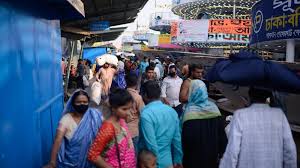
Bangladesh has made it to the list of countries with most coronavirus cases with confirmed infections crossing 60,000 in 90 days after the first COVID-19 patient was detected in the country.
Only Qatar is now between Bangladesh and China, where the pandemic began, on the list, according to tallies by the Johns Hopkins University.
Another 2,828 new cases of COVID-19 were confirmed in the 24 hours to 8 am on Friday, bringing the tally of infections to 60,391, the health directorate said.
The official death toll from the novel coronavirus infection in Bangladesh also climbed to 811 after 30 new fatalities were registered in a daily count.
Professor Nazrul Islam, a member of the national technical advisory committee to tackle the outbreak, believes the infection curve of the country will rise further in the next week.
He expressed frustration over sample collection outside the most affected areas. “Moreover, we can’t calculate properly the sample collection which should be done uniformly,” he told bdnews24.com on Friday.
“Now the nature of the virus and our efforts to prevent infection appear conflicting to me. Let’s see who win – the virus or we.”
Since the detection of the first case on Mar 8, Bangladesh has conducted coronavirus tests on total 372,065 samples.
As many as 14,088 samples were tested at 50 authorised labs across the country in the 24 hours to Friday morning.
Globally, over 6.68 million people have been infected by the novel coronavirus and nearly 392,000 have died until 10:30pm on Friday, the Johns Hopkins University data showed.
The US tops the list of affected countries with nearly 1.9 million cases and more than 108,000 deaths. Brazil, Russia and the UK are behind the US on the list.
In South Asia, India has the highest number of cases – over 233,000. It is seventh among the worst-hit countries globally. Pakistan is on No. 17 with nearly 90,000 infections.
Bhutan is in the best position in the region, recording only 48 patients.
Sri Lanka has 1,800 cases, the Maldives 1,872, Nepal 2,912, and Afghanistan 18,969.
The number of COVID-19 cases in India has been doubling every three weeks but the epidemic is not growing exponentially in the country and South Asia region, the World Health Organisation or WHO said on Friday, Reuters reported.
“In South Asia, not just in India, but in Bangladesh and… Pakistan and other countries of South Asia with large dense populations, the disease has not exploded, but there is always the risk of that happening,” Dr Mike Ryan, WHO’s top emergency expert, told a news conference in Geneva.
Soumya Swaminathan, WHO’s chief scientist, noting India has a population of 1.3 billion, said that the 200,000 reported cases, “look big but for a country of this size it’s still modest”.
THE SAD MILESTONE
The real picture of the epidemic in Bangladesh was ambiguous initially as the government’s disease control agency IEDCR had the only lab to run COVID-19 tests in the country.
As the country started expanded testing facilities and allowed some readymade garment factories to reopen, leading thousands of workers to travel by foot or use crammed transports amid a nationwide shutdown, the number of infections began rising rapidly in mid-April.
On Apr 14, the health directorate reported 209 confirmed cases, taking the total to 1,012. The caseload crossed 10,000 after 20 more days. The daily infection rate neared 700 by the time.
It took 11 more days for Bangladesh to register the next 10,000 coronavirus cases.
The number of infections crossed 30,000 after seven more days and 40,000 after another six days.
The time to reach 50,000 cases by registering another 10,000 was only four days. After three more days on Friday, Bangladesh reported it has reached the 60,000 mark.
Health experts, however, fear the number of coronavirus infections and deaths from COVID-19 could be much higher if it had been possible to run more tests.

THE WORST IS YET TO COME
The government reopened offices and public transport system on Mar 31 after over two months of a lockdown in the form of general holidays and stay-at-home orders.
Less than a week after lifting almost all the restrictions, the local authorities in Cox’s Bazar had to put the municipality on lockdown again, declaring it a red zone with maximum infection risk as the number of coronavirus cases began rising rapidly there.
Prof Nazrul, former vice-chancellor of Bangabandhu Sheikh Mujib Medical University, believes the daily infection rate will reach the highest level by Jun 10 because many are still returning to Dhaka and other cities after the offices reopened.
“And we have another Eid, the Eid-ul-Azha, ahead. The outbreak will peak again at that time,” he said.
Prof Nazrul lamented a lack of efforts to ensure that the lockdown was being strictly enforced.
He said the authorities were able to enforce a proper and total lockdown at only Tolarbagh in Dhaka’s Mirpur, where one of the first clusters of infections was reported.
“We had seen the effects. The rate infection has gone down there,” he said.
“But what happened elsewhere? Even the army patrolled the streets along with the police, but the situation didn’t change. We must enforce a true lockdown if we want good results,” the member of the national committee said.
Source: bdnews24.com

